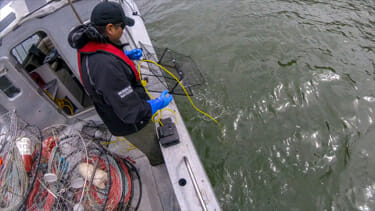Estimated Reading time

2 Mins
Central Coast First Nations Work to Eradicate Invasive Species
The Central Coast Indigenous Resource Alliance (CCIRA), is expanding on work instigated by Heiltsuk Nation to eradicate invasive species along the central coast of British Columbia. With support from Coast Funds, the Heiltsuk Integrated Resource Management Department has worked to monitor and plan eradication of the population of green grabs in their territory for the past decade.

Now CCIRA is partnering with the Government of BC to expand the work of the Heiltsuk Nation to implement the Marine Plan Partnership on the central coast through a coordinated response to three invasive species: European green crab, tunicates, and bryozoa.
A recent article on the Marine Plan Partnership website describes relentless work of CCIRA (comprised of the Heiltsuk, Kitasoo/Xai’xais, Nuxalk, and Wuikinuxv First Nations) to control the invasive species.
More than 10 people (Guardian Watchmen and other fieldworkers) from the four Nations are now monitoring these aquatic invaders, collecting critical baseline data on their presence, abundance, and damage to the ecosystem.
Tristan Blaine is, a field technician working for the Central Coast Indigenous Resource Alliance, describes the challenge of “biofouling” from tunicates and bryozoa: “You clean them off [marine structures], and a month later they’ve totally regrown. The amount of work involved is pretty concerning.”
Invasive species like green grabs and tunicates are one of 27 indicators that CCIRA has chosen to track in order to monitor changes in the marine environments of their territories. By tracking these indicators, they will be able to adapt their management decisions in response to changes in the environment.
Learn more about how First Nations are enhancing well-being in their communities through scientific research and habitat restoration.
